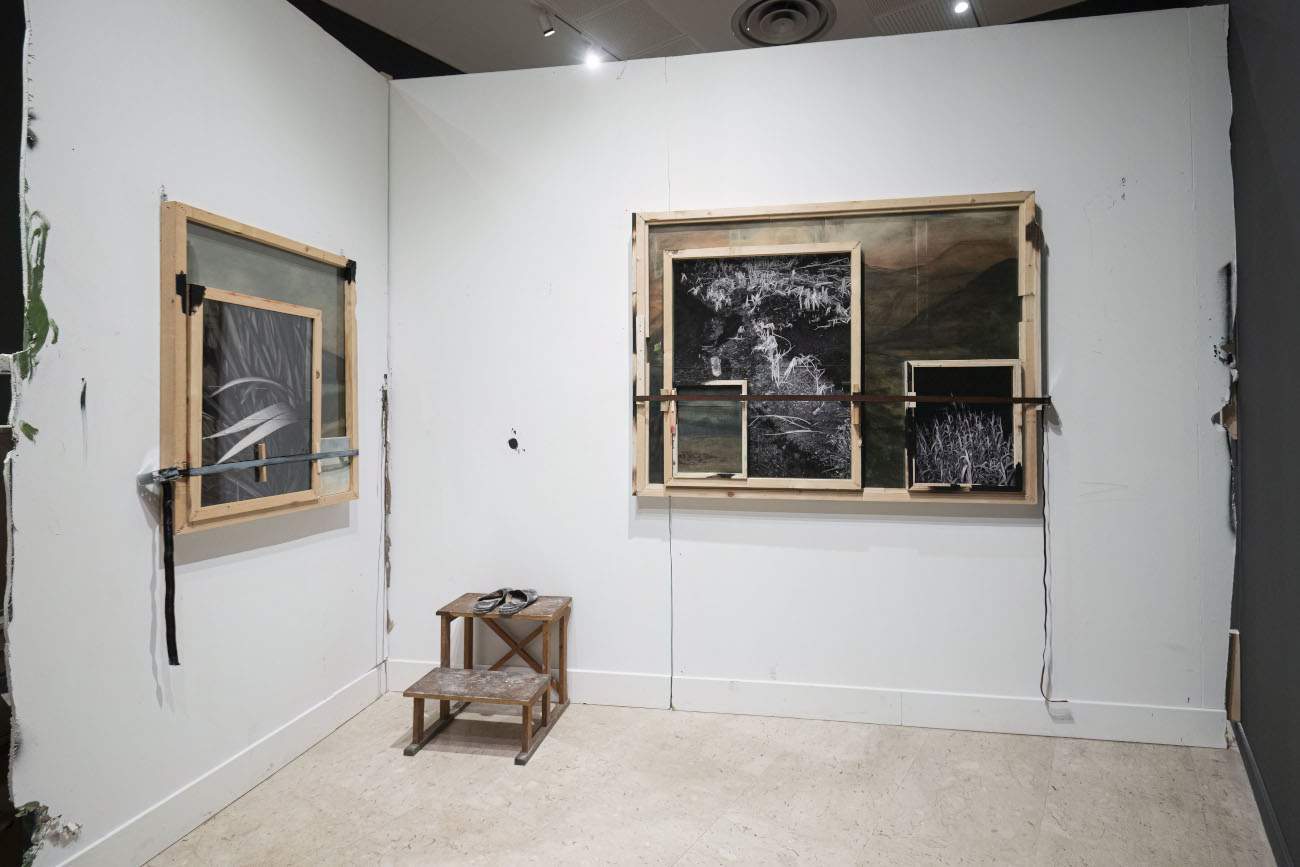GAM Galleria Civica d’Arte Moderna e Contemporanea in Turin, Italy, presents the exhibition of artist Jacopo Benassi entitled Jacopo Benassi. Criminal Self-Portrait, curated by Elena Volpato and open to visitors from February 27 to September 1, 2024. The exhibition stems from the arrival in the museum collection of the work Panorama of La Spezia, 2022, acquired by the CRT Foundation for Modern and Contemporary Art. It is a self-portrait in which the artist never appears, just as the human presence does not appear. Instead, photos appear of plants taken in the dark of night at the public gardens, plants that cover, at least partially, some views of the Ligurian city painted with a vague nineteenth-century flavor. Overlapping photos and canvases, held together by thick straps, hang on two plasterboard walls that served for a while as the artist’s temporary studio while he prepared for an exhibition in his own hometown of La Spezia.
Since that occasion, Benassi’s work has gradually shifted from photography to a shadowy space between photos and paintings, between photos and plaster casts.
Behind the installation of Panorama of La Spezia appears Series of Hanging Portraits, 2024, made on the occasion of the exhibition: a work that takes the process of erasure to its extreme consequences, presenting suspended in the void a heavy sandwich of frames of which only two retrials can be seen. Benassi presents a series of photographic portraits, including celebrities such as Valentino, Nan Goldin, John Wayne and Snow White, combined with self-portraits. However, the artist paradoxically reactivates these images, giving them a new evocative power through negation. Prominent among the self-portraits is one in which Benassi looks at us from behind the long bangs of a woman’s hairstyle, and under that fixed gaze we find ourselves questioning the raw flavor of truth that a disguise can have. Photography itself can be both a truthful masquerade and a disguised truth, exploring the duality between reality and fiction in its long history. The self-portrait takes on a criminal dimension, harking back to the tradition of filing and photographing transvestites, but also playing with the codes of mugshot portraits, influenced by Sergio Fregoso ’s teaching and Ando Gilardi’s reading of Wanted! Thinking about this early matrix of his work, it will not seem strange to find in the exhibition the large plaster sketch preserved in the GAM collections that Leonardo Bistolfi made for the monument to his friend Cesare Lombroso, shortly after his death, around 1910. The timbers that hold Bistolfi’s work together, frayed and shattered, resonate with the straps that hold the photos and paintings in the exhibition: symbols of strength and fragility together. Benassi responds in the exhibition to the dark gaze of Bistolfi’s skull with other plaster skulls, scattered, repeated, deformed, restless skulls. He has also included them in a video, also titled Criminal Self-Portrait, along with countless shots of the plaster death masks that appear in the cases of the Cesare Lombroso Museum in Turin.
An additional disappearing portrait joins the exhibition, contributing to the ideal dialogue with Ando Gilardi and the memory of Lombroso. It is the portrait of the greatest criminal in history, as Elena Volpato writes, “called on stage perhaps to attempt an impossible erasure under a thick layer of glass. Not just any glass, but glass recovered from the studio of a painter from La Spezia, Manlio Argenti, as if in addition to the thickness there was a need for further superimposition, for the interposition of a memory of other painted images, of the distancing evocation of other people’s works, to increase the capacity of glass to make a veil, to blur the unbearable dimension of crime that Hitler’s portrait carries, even the one taken by Benassi, in perfect sign style, of his puppet present in London’s wax museum. Despite being the features of a mask, despite being a representation of a representation, despite the large number of glass panes interposed, the well-known effigy continues to emerge. And so we restart the life cycle of the image that continually disappears to reappear, between visual noise and deep silence, between overexposure and darkness. In Benassi, everything that surfaces sinks, and everything that sinks resurfaces.”
The Fondazione per l’Arte Moderna e Contemporanea CRT, the “Cesare Lombroso” Museum of Criminal Anthropology, Augustin Laforêt and the Francesca Minini Gallery collaborated on the exhibition.
Image: Jacopo Benassi, Panorama of La Spezia (2022; environmental work: fine art prints, acrylics on canvas, artist’s frames, wooden panels and structures, variable size; Turin, Fondazione per l’arte moderna e contemporanea CRT, GAM - Galleria Civica d’Arte Moderna e Contemporanea). Photo by Giorgio Perottino
 |
| Works by Jacopo Benassi go on display at GAM in Turin. |
Warning: the translation into English of the original Italian article was created using automatic tools. We undertake to review all articles, but we do not guarantee the total absence of inaccuracies in the translation due to the program. You can find the original by clicking on the ITA button. If you find any mistake,please contact us.